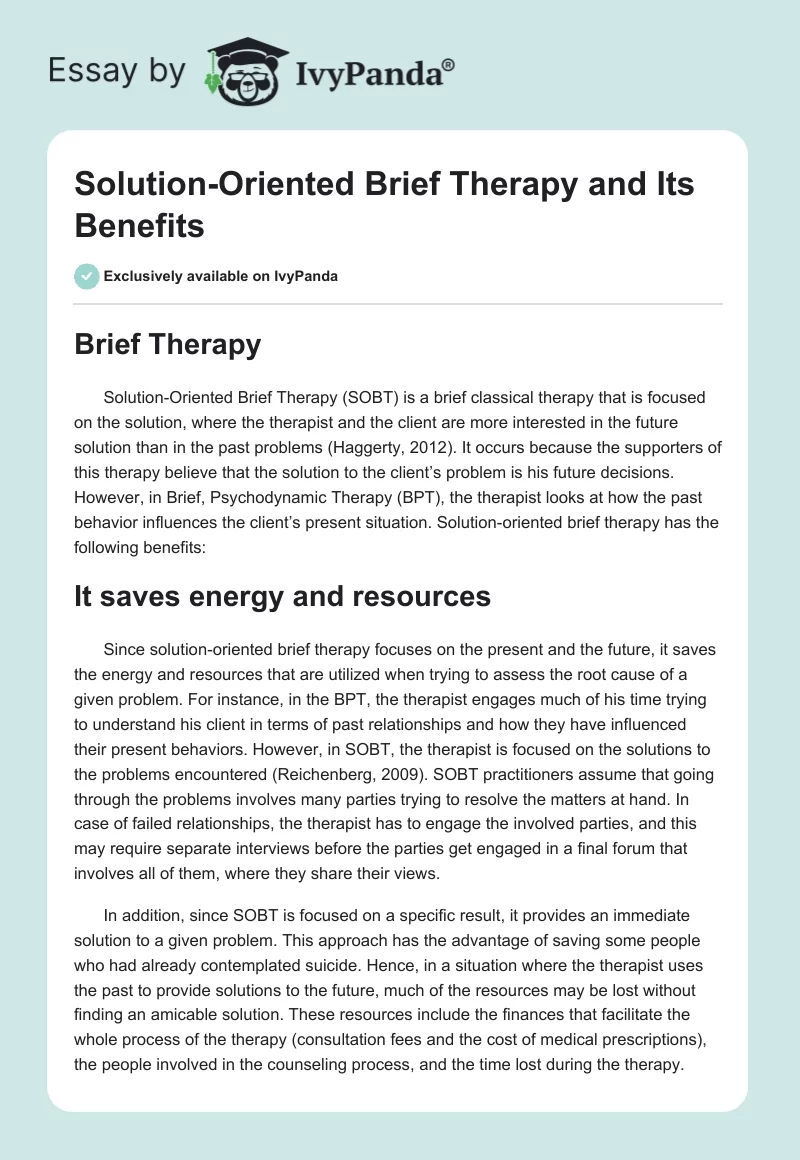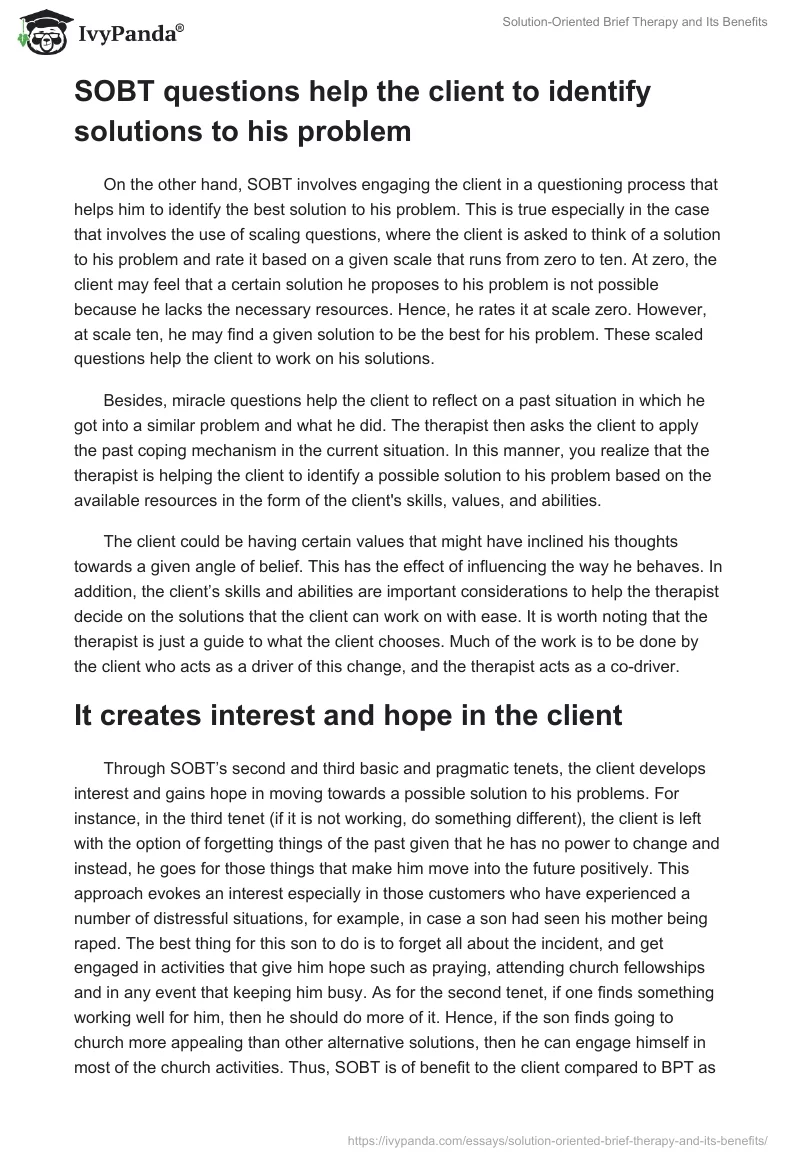Brief Therapy
Solution-Oriented Brief Therapy (SOBT) is a brief classical therapy that is focused on the solution, where the therapist and the client are more interested in the future solution than in the past problems (Haggerty, 2012). It occurs because the supporters of this therapy believe that the solution to the client’s problem is his future decisions. However, in Brief, Psychodynamic Therapy (BPT), the therapist looks at how the past behavior influences the client’s present situation. Solution-oriented brief therapy has the following benefits:
It saves energy and resources
Since solution-oriented brief therapy focuses on the present and the future, it saves the energy and resources that are utilized when trying to assess the root cause of a given problem. For instance, in the BPT, the therapist engages much of his time trying to understand his client in terms of past relationships and how they have influenced their present behaviors. However, in SOBT, the therapist is focused on the solutions to the problems encountered (Reichenberg, 2009). SOBT practitioners assume that going through the problems involves many parties trying to resolve the matters at hand. In case of failed relationships, the therapist has to engage the involved parties, and this may require separate interviews before the parties get engaged in a final forum that involves all of them, where they share their views.
In addition, since SOBT is focused on a specific result, it provides an immediate solution to a given problem. This approach has the advantage of saving some people who had already contemplated suicide. Hence, in a situation where the therapist uses the past to provide solutions to the future, much of the resources may be lost without finding an amicable solution. These resources include the finances that facilitate the whole process of the therapy (consultation fees and the cost of medical prescriptions), the people involved in the counseling process, and the time lost during the therapy.
SOBT questions help the client to identify solutions to his problem
On the other hand, SOBT involves engaging the client in a questioning process that helps him to identify the best solution to his problem. This is true especially in the case that involves the use of scaling questions, where the client is asked to think of a solution to his problem and rate it based on a given scale that runs from zero to ten. At zero, the client may feel that a certain solution he proposes to his problem is not possible because he lacks the necessary resources. Hence, he rates it at scale zero. However, at scale ten, he may find a given solution to be the best for his problem. These scaled questions help the client to work on his solutions.
Besides, miracle questions help the client to reflect on a past situation in which he got into a similar problem and what he did. The therapist then asks the client to apply the past coping mechanism in the current situation. In this manner, you realize that the therapist is helping the client to identify a possible solution to his problem based on the available resources in the form of the client’s skills, values, and abilities.
The client could be having certain values that might have inclined his thoughts towards a given angle of belief. This has the effect of influencing the way he behaves. In addition, the client’s skills and abilities are important considerations to help the therapist decide on the solutions that the client can work on with ease. It is worth noting that the therapist is just a guide to what the client chooses. Much of the work is to be done by the client who acts as a driver of this change, and the therapist acts as a co-driver.
It creates interest and hope in the client
Through SOBT’s second and third basic and pragmatic tenets, the client develops interest and gains hope in moving towards a possible solution to his problems. For instance, in the third tenet (if it is not working, do something different), the client is left with the option of forgetting things of the past given that he has no power to change and instead, he goes for those things that make him move into the future positively. This approach evokes an interest especially in those customers who have experienced a number of distressful situations, for example, in case a son had seen his mother being raped. The best thing for this son to do is to forget all about the incident, and get engaged in activities that give him hope such as praying, attending church fellowships and in any event that keeping him busy. As for the second tenet, if one finds something working well for him, then he should do more of it. Hence, if the son finds going to church more appealing than other alternative solutions, then he can engage himself in most of the church activities. Thus, SOBT is of benefit to the client compared to BPT as it focuses on providing hope and creating interest and not traumatizing the client by bringing his past problems on board when assessing the client.
In general, BPT differs with SOBT in the fact that it assumes that the client cannot get a solution without getting into the root cause of his problem. Hence, BPT therapists assume that they have solutions to their clients’ problems and, therefore, work towards helping their clients identify the symptoms and eliminate them (Haggerty, 2012). However, SOBT therapists’ belief is different. They assume that their clients have the solutions to their problems and hence, the therapists engage them in questions that help them identify those solutions based on their resources. The SOBT therapists also assume that change is a continuous process that is inevitable and should be embraced in our solution-seeking procedures. They also consider change to be dynamic.
I am more inclined to SOBT than to BPT. However, it is presumed that getting into the root cause of a problem helps in trying to avoid a repeat of the same problem in the future because the client gets to understand the history of his problem in terms of its causes, signs and symptoms and how to manage it if he encounters it again in the future. It is worth noting that, not all problems can be avoided by knowing their cause. As a result, the Brief Psychodynamic Therapy loses a lot of resources as the therapists try to establish the root cause of a given problem.
In my opinion, the short term focus that is adopted by SOBT provides quick solutions to clients and hence it is able to meet their needs in time. Besides, it helps the therapist to serve more clients, saves resources and also engages the client in the solution-seeking process. SOBT is the best approach because the therapist assesses the capabilities of the client before helping him choose the appropriate solution to his problems. This way, the client gets motivated and realizes that he has found a solution to his predicaments.
References
Haggerty, J. (2012). Psychodynamic therapy: Brief psychodynamic therapy. South Melbourne, Victoria: Thomson Learning.
Reichenberg, L. (2009). Counseling and psychotherapy: Solution focused brief therapy. Boston: Pearson.


